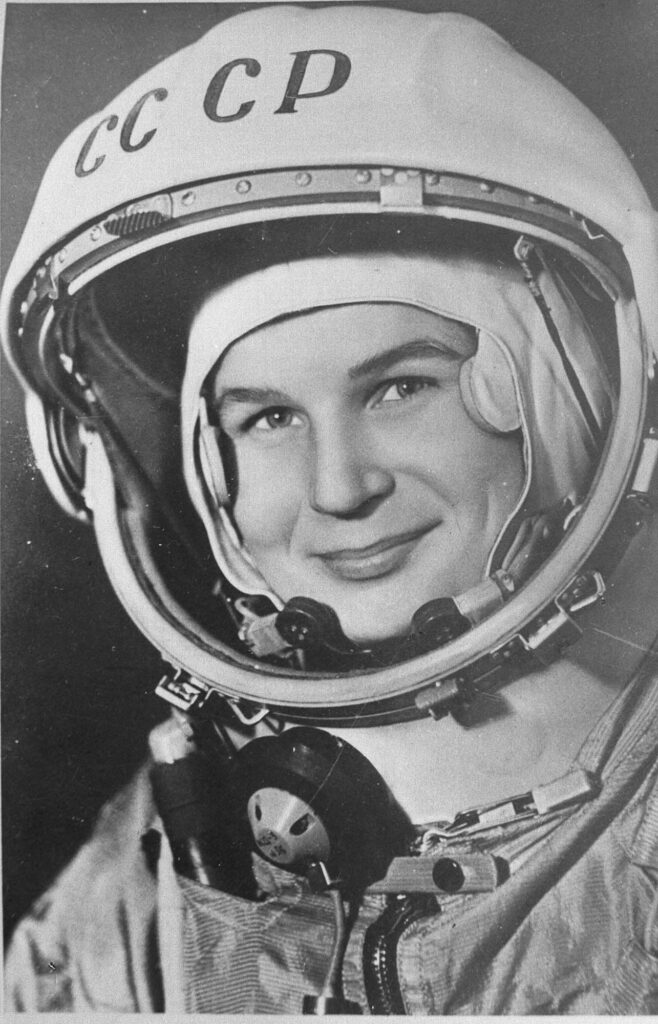Valentina Vladimirovna Tereshkova was born on March 6, 1937, in the village of Maslennikovo, near Yaroslavl in western Russia. Her father, a tractor driver before enlisting in the Red Army, was killed fighting the Nazis during World War II, leaving her mother to raise Valentina and two siblings. Tereshkova was not able to attend school until she was eight, and had to withdraw to work in the same textile plant as her mother when she was sixteen. Despite economic hardships, she continued her education through correspondence courses, and in 1959, began to parachute as a hobby. By 1961 Valentina Tereshkova had parachuted out of more than 125 aircraft.
When Tereshkova and four other female cosmonauts were selected for the Soviet space program on March 12, 1962, she became the first cosmonaut recruit who lacked experience as a test pilot. Her selection was instead based on her parachuting skills (early Soviet craft had to be exited via parachute prior to landing) and propaganda values such as her proletarian background, and war hero father. Tereshkova was assigned to be the pilot of the Vostok 6 mission. Her radio call sign was “Chaika,” Russian for “seagull.”
Vostok 6 lifted off from Tyuratam Launch Center (now Baikanor Cosmodrome), Kazakhstan on June 16, 1963. It remained in space for nearly three days and orbited the Earth 48 times, giving Tereshkova more time in space than all of the American Mercury astronauts combined. Vostok 6 reentered the Earth’s atmosphere on June 19, and Tereshkova parachuted to the ground, as all early cosmonauts had to do. She became a worldwide celebrity, as the first woman in space, and the first woman in orbit.
Soviet Chief Designer Sergei Korolev was reportedly unhappy with Tereshkova’s performance and claimed she was “on the edge of psychological instability” during the flight. She later retorted, “I felt fine after 24 hours and asked the state commission to prolong my stay in space to three days. And I carried out the entire schedule. Could I have done that if I had been half-dead?” Ultimately, it would be another nineteen years before another woman entered outer space (Svetlana Savitskaya, aboard Soyuz-T 7). In her one flight, Valentina Tereshkova spent a total of 2.95 days in space.
Tereshkova and her fellow female cosmonauts were never an integral part of the cosmonaut corps nor were they treated on an equal basis with the male cosmonauts as the Soviet government prized them primarily for propaganda purposes. She was scheduled to command an all-female flight aboard a Voskhod spacecraft in 1965, but this was canceled after the many problems identified with the Voskhod 2 mission in March 1965. The female cosmonaut program was disbanded in 1969, and it wasn’t until the early 1980’s that another female cosmonaut group was recruited, and that was in response to the United States training female astronauts for its Space Shuttle program.
After her flight, Valentina Tereshkova became a prominent member of the Communist Party and a representative of the Soviet government to numerous international women’s organizations and events. In 1964, Tereshkova enrolled in the Zhukovskiy Military Air Academy, graduating with distinction five years later. She was also a member of the World Peace Council in 1966, a member of the Yaroslavl Supreme Soviet in 1967, and a member of the council of the Union of the Supreme Soviet from 1966 to 1974, when she was elected to the presidium of the Supreme Soviet in 1974.
She was the Soviet representative to the UN Conference for the International Women’s Year in Mexico City in 1975. Her other honors include the rank of deputy to the Supreme Soviet; membership in the Communist Party of the Soviet Union Central Committee; Vice President of the International Woman’s Democratic Federation; and President of the Soviet-Algerian Friendship Society.
With the collapse of the Soviet Union in 1991, Tereshkova lost her political standing. She left the space service with the rank of colonel-engineer on April 30, 1997, and is thought to have retired in Moscow. She is still revered as a Russian heroine, and to many of her countrymen, her importance in Russian space history is second only to that of Yuri Gagarin and Alexei Leonov. Since her retirement from politics, she appears in public only rarely, usually at space-related events. Tereshkova Crater on the Moon and asteroid 1671 Seagull (her radio call sign) are named in her honor.

